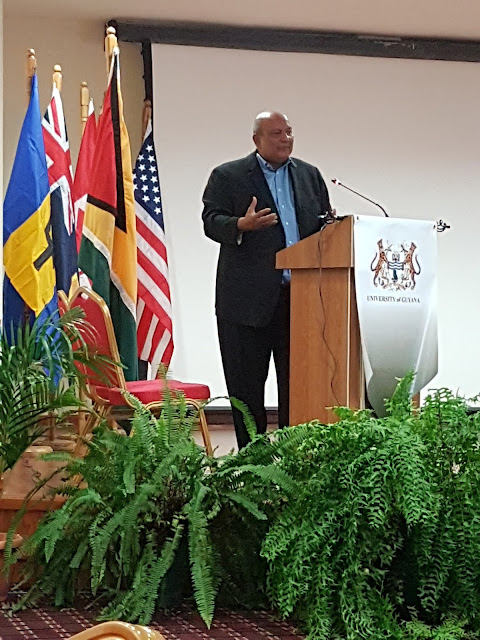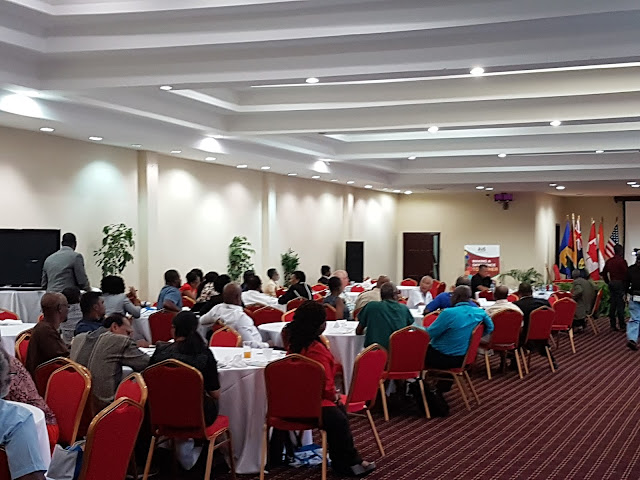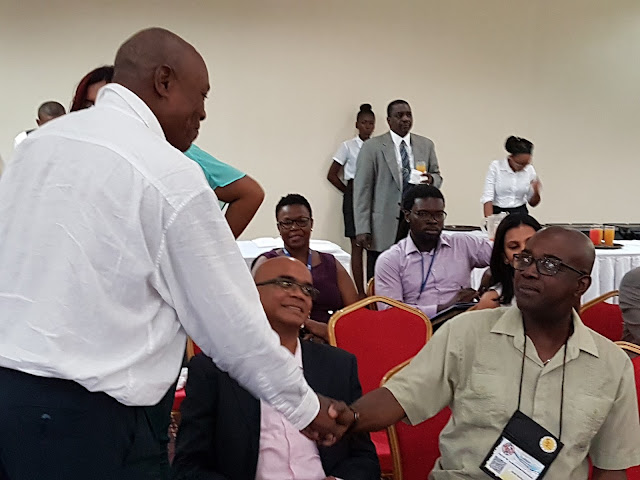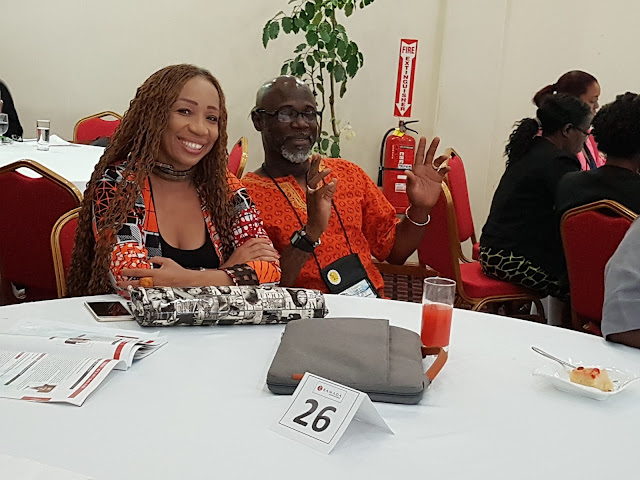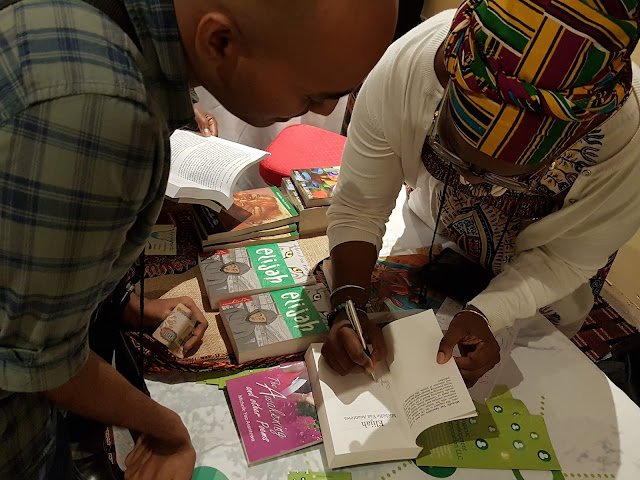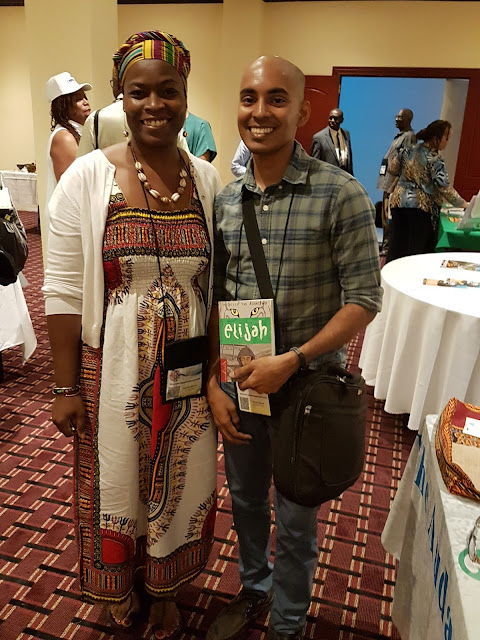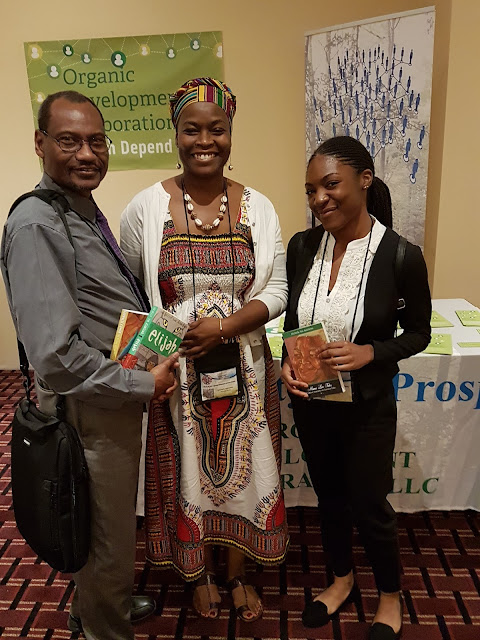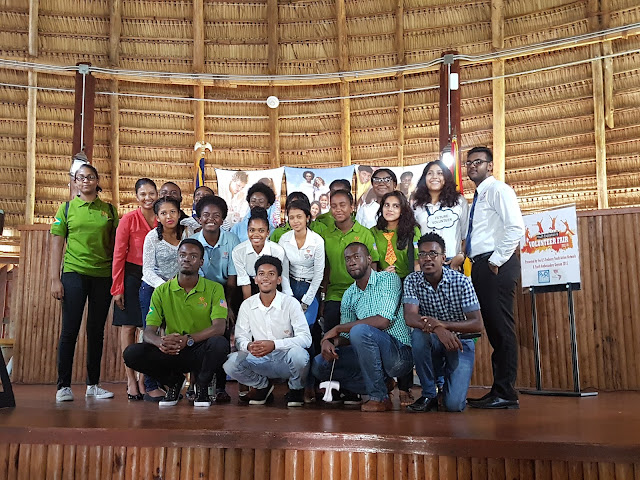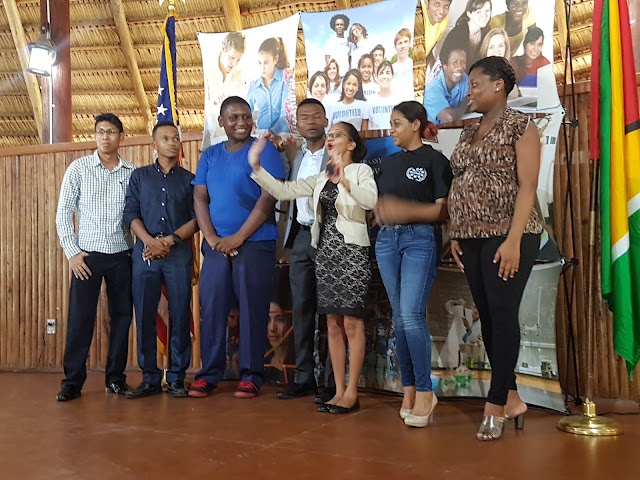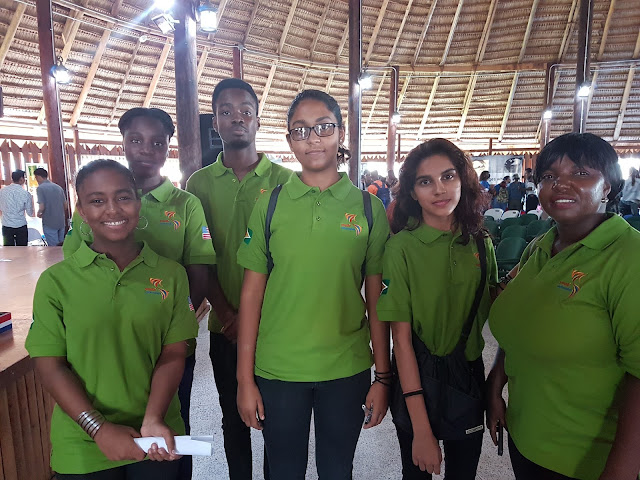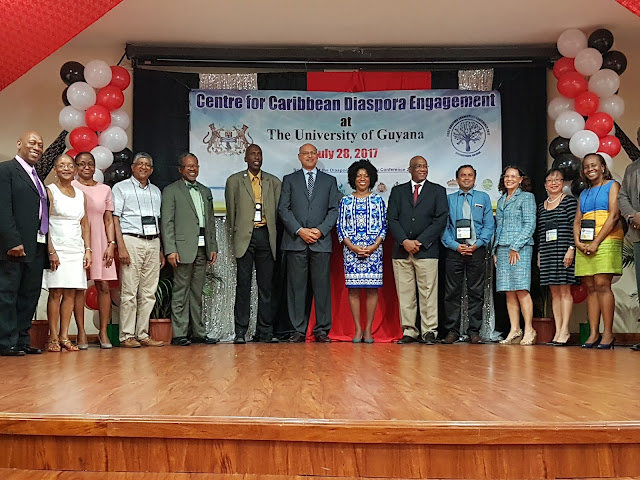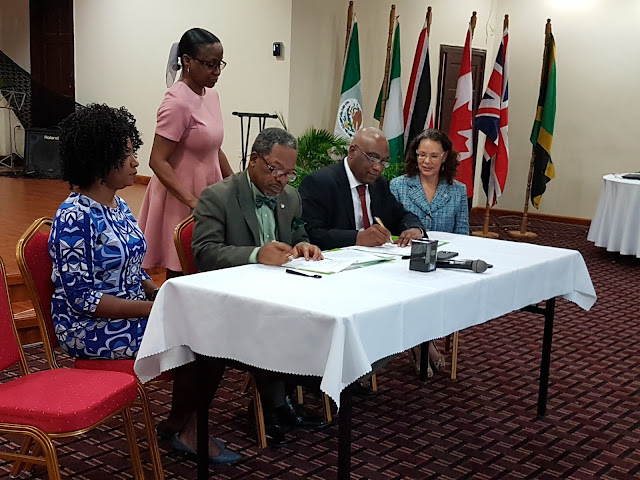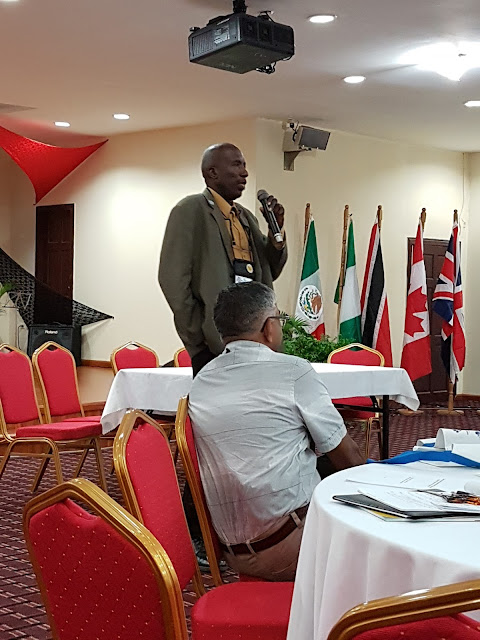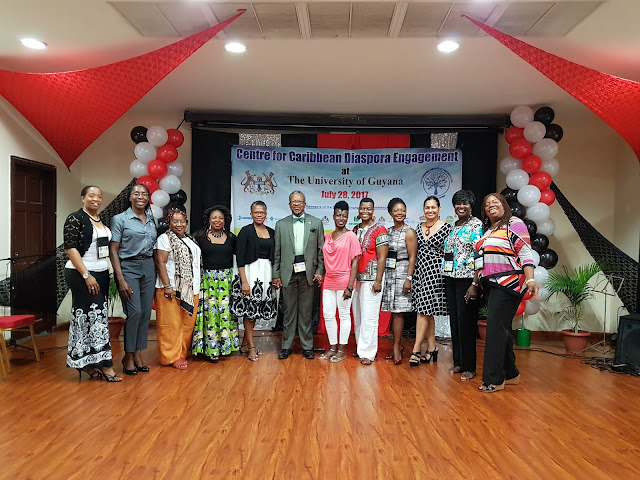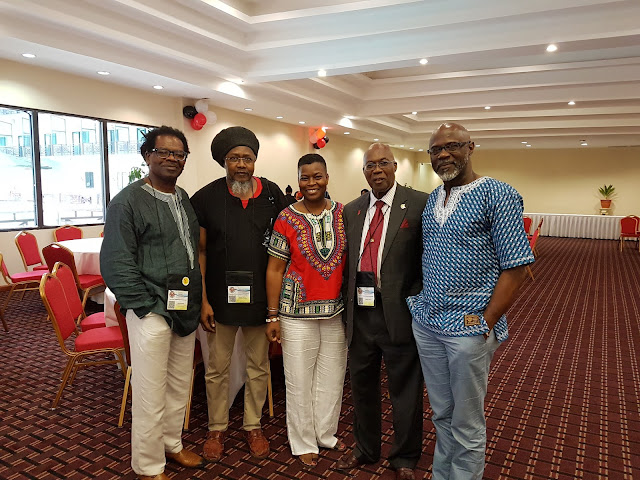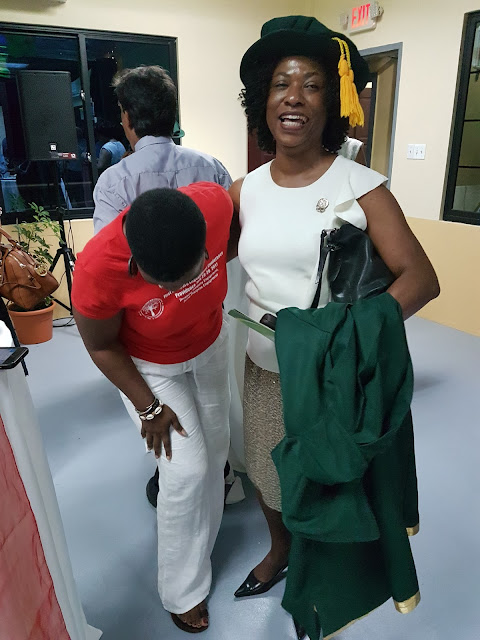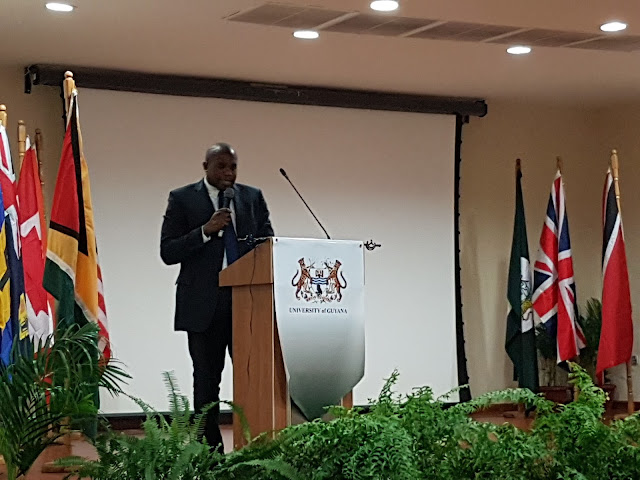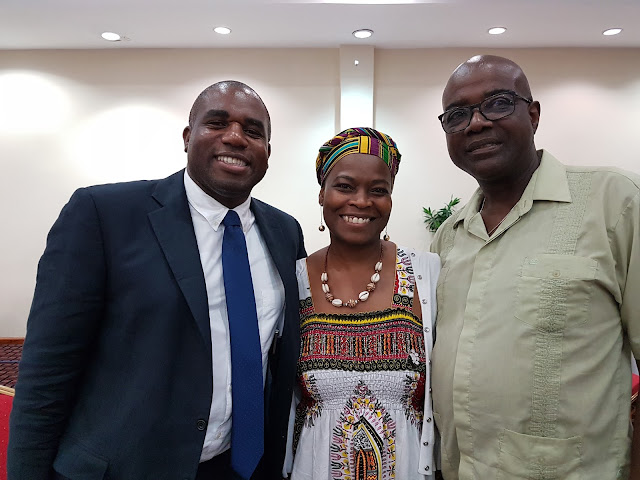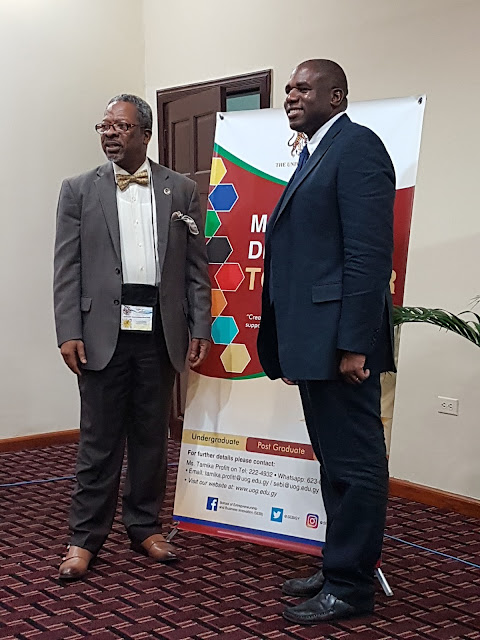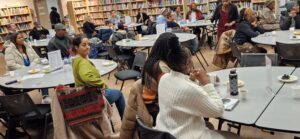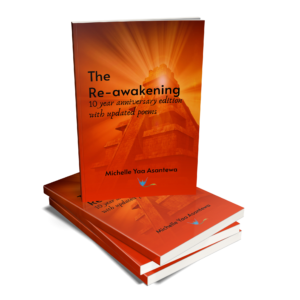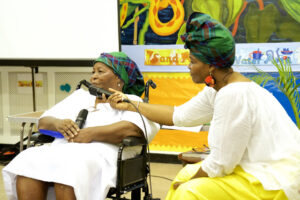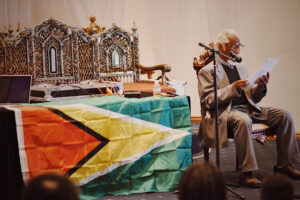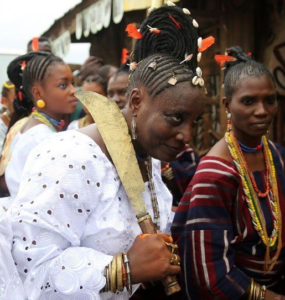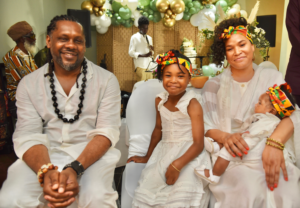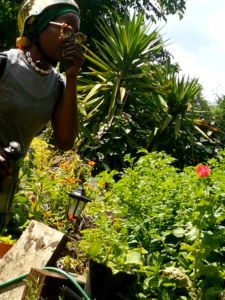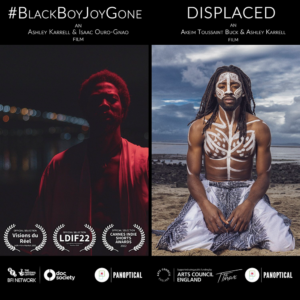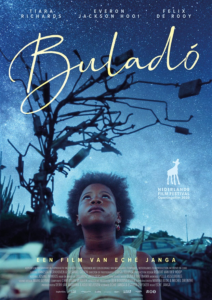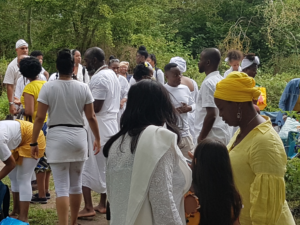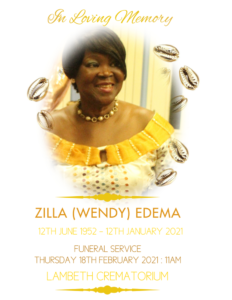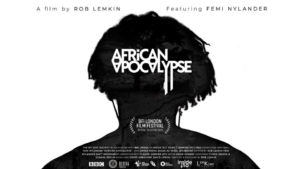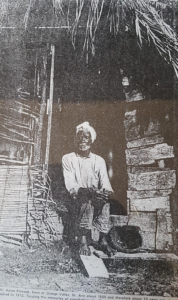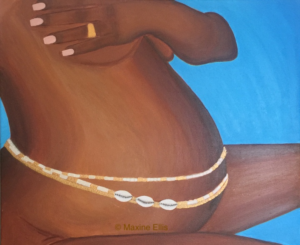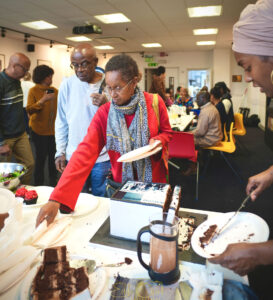
Disclaimer: Use of Copyrighted Images
The images used on this
blog and in our newsletters are sourced for educational purposes only.
These images are the property of their respective copyright holders and
are used under the principle of *fair use* to support commentary,
analysis, and discussion. We make no claim of ownership over any
copyrighted images and have taken all reasonable steps to attribute them
appropriately.
If you are the copyright owner of any image
featured here and believe it is being used improperly, please contact us
directly. We are committed to respecting intellectual property rights
and will take prompt action to resolve any concerns.
This content
is not intended for commercial use, and any reproduction or
distribution of the images without proper authorization may violate
copyright laws.
Guyana trip July 2017 I: Diaspora Engagement Conference
-
 By
Dr Michelle Yaa Asantewa
By
Dr Michelle Yaa Asantewa
- 17 minutes
- Article
Share
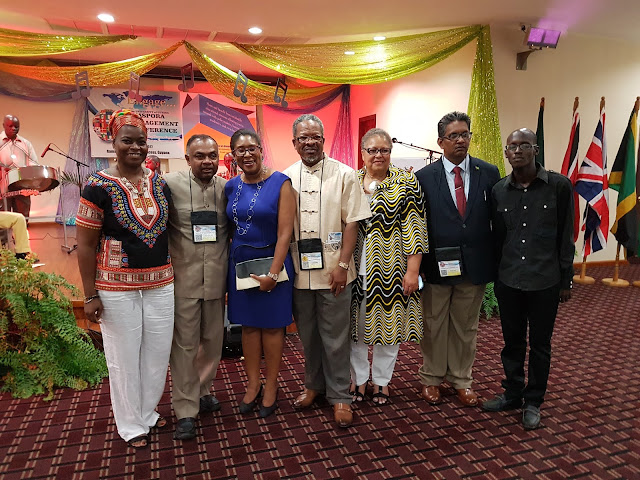

Reluctant ParticipantThe theme ‘Dreaming Diaspora: Doing Diaspora’ sounded fluffy. This wasn’t the reason I didn’t initially want to go to the conference. I knew I couldn’t afford it! From the outset, I understood that it would have to be self-funded, given that I’m not attached to an academic institution, but am independent, based in the UK, where average travel fare to Guyana would cost £700. But in July! Double that. I decided I wouldn’t go. It kept pushing me to attend, however, and finally, I agreed I’d find the funds and go. My decision to finally go was due in part to a sense that there would be few if any presentations on culture. I was right. Even so, what could I really contribute? When the current administration took office, ‘business’ for developing the economy was its focus; our High Commissioner here in the UK was formerly in business. I saw a future in which the arts and culture were forced off centre as the poor cousin of advancing the nation’s economy. My paper/presentation would highlight that culture is the bedrock of societies and should not be sidelined since it is issued from the peoples that make up our communities and societies. What culture needs in order to contribute effectively to economies is for the government to institutionalise processes for creative industries to develop and thrive. As they do in the UK and elsewhere, ‘inward investment’ is necessary, along with securing music (where we at with copyrights?) and consistent education programmes.Active Participant
The conference opened on Sunday 23rd July with a reception. Some anxieties about feeling out of place among the suits and business people dominated. One of the first people I met, who settled some of my misgivings was my cousin, Michael Brotherson. He works in the Foreign Office, headed by Karl Greenidge, the Minister of Foreign Affairs whose absence did not go unnoticed. I was surprised but had no choice but to rise to it, when Vice Chancellor Professor Ivelaw Griffith asked me along with others to say a few words about the conference. I waited my turn, all the while styling anxieties about what I’d say. I was the last to speak. Thankfully the speaker before me, Paul Tennassee (University of the District of Columbia) had closed his remarks by introducing a young poet called Keon Heywood, who performed a wonderful piece about Guyana. The springboard was easy; he’d allowed me to highlight the importance of culture and arts in all our engagement about how to develop Guyana, to remember that culture too is business and key to our humanity. Professor Griffith did an intriguing thing giving me that momentary platform, totally unprepared as I was. After I spoke, he was able to confirm that as well as the newly developed Business/Enterprise Unit at the university there were plans too for developing the Arts. I knew of this in any case from previous conversations with the Vice Chancellor. I would embrace the conference with confidence now and appreciate that I had a place there.
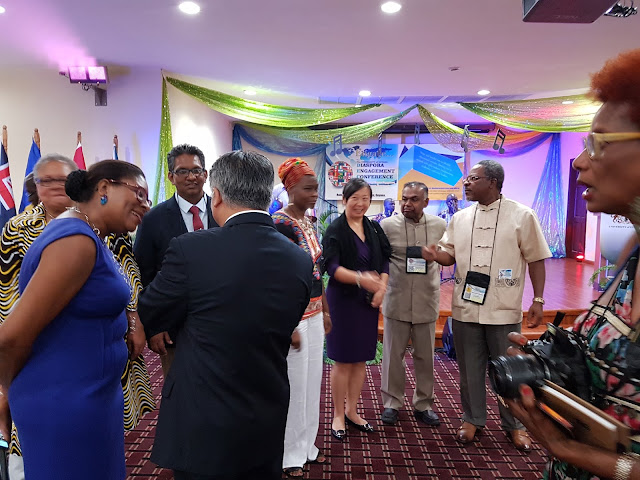
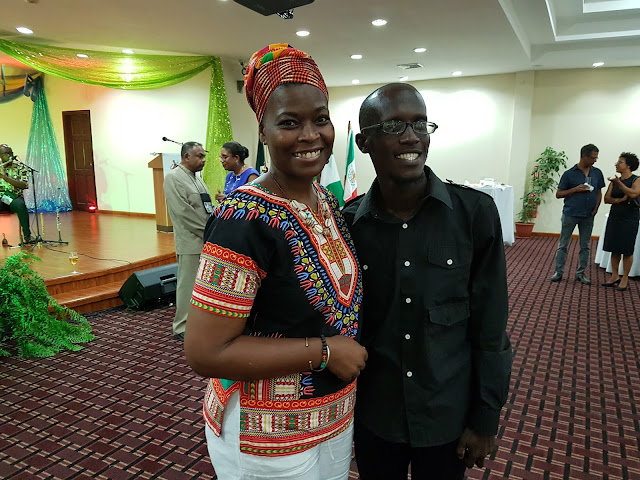
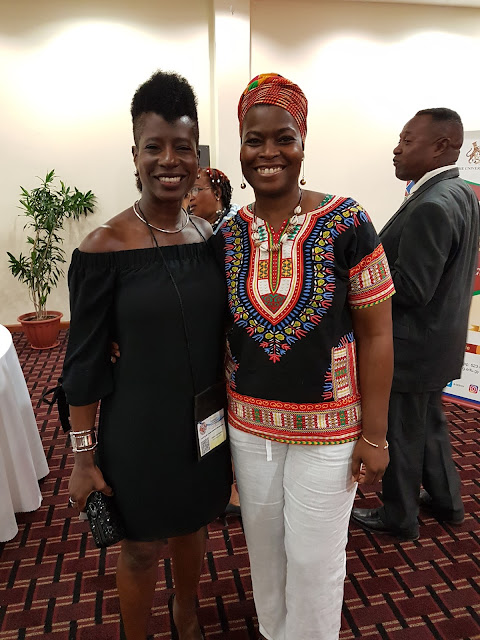
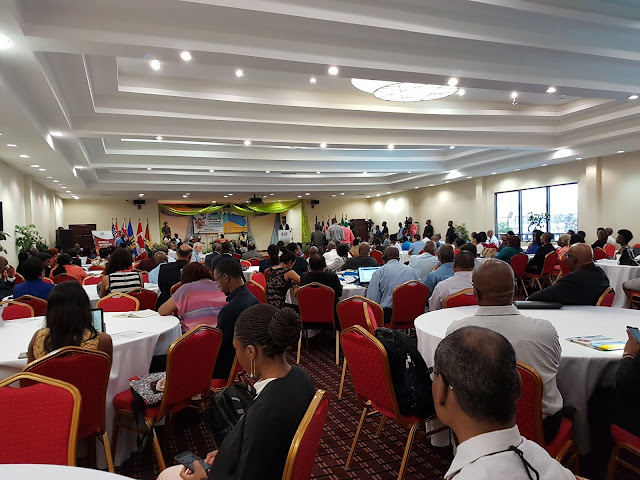
The Papers and Presentations
It was impossible to attend most as I’d hoped but that’s the nature of conferences. I read a sour note on FaceBook that some of the presenters sounded as though they’d swallowed a dictionary. It was perhaps difficult for this observer to appreciate the quality of the papers and that it was a conference initiated by the University where one would expect the calibre of contributions I saw. What was lacking was sufficient time for us to digest and question the presenters and also better rooms to better facilitate the PowerPoint slides. We ran way over time the first day of the conference, which was due in part to the opening formalities that included a Keynote address by President David Granger. The fact that the University had sought to include the government as well as opposition leaders marked its intention to have far reaching inclusion and obviously to highlight the important role each need to play to engage the diaspora effectively if we are serious about development.
There were excellent, if hurried papers from the Theme: ‘Engaging the Diaspora’ – which included methods relating to policy development to utilise the potential of the diaspora; entrepreneurship and investment possibilities that move beyond remittances and establishing a methodology for researching the diaspora; Building Partnerships with the Diaspora Theme saw papers on creating a ‘multi-dimensional Process for engaging the Diaspora’ and exploring the reality of the resources (skills based and financial) of the diaspora. A paper I enjoyed was on the government Green State initiative, pushing for us to explore and implement renewable energy as an industry, delivered by Gary Best. It’s a commendable initiative but my misgivings about the oil exploration and development make it difficult to be convinced about how the two will mesh. I caught only an enticing tail end of ‘Mimicry and Fantasy in the Diaspora: the view from Richmond Hill in New York’ by Dr Dhanpaul Narine but others said it was a treat.
My presentation was titled ‘Embedding Guyanese Culture’ and showcased a few organisations/initiatives based in the UK, Bogle L’Ouverture Publications, Huntley Conference, Guyana UK Sports and Development Association, Way Wive Wordz and ‘Guyana Speaks!’ It emphasised the need to institutionalise/embed culture for it to effectively matter in development strategies. It was well received, though time didn’t allow for any questions following.
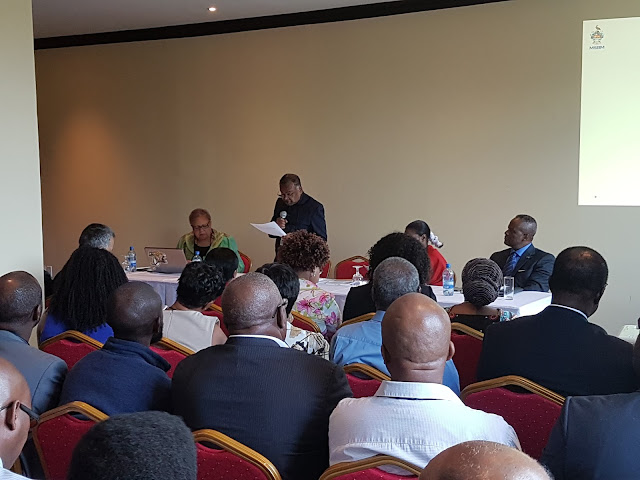
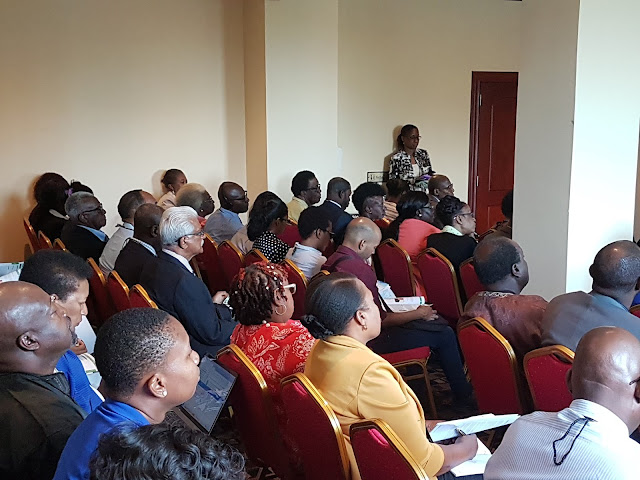
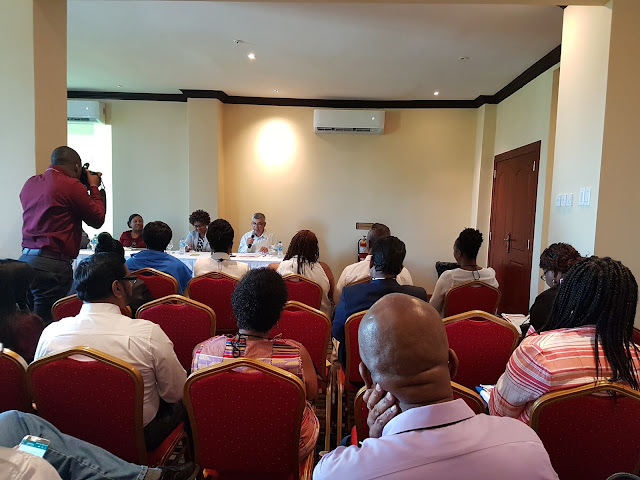
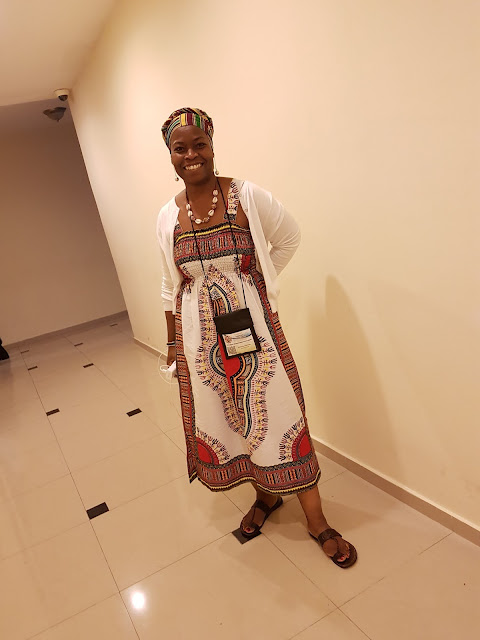
It was several times noted that the Diaspora contributed around $US450 Million in remittances, with the majority of Guyanese located in the USA. Although the US based Guyanese dominated, I was actually really impressed by the enthusiasm, initiatives (educational as well as business related investments) and experience they amass. For example, Dr Vincent Adams, one of the appointed Education Ambassadors has 30 odd years’ experience in oil and gas. He will be lending his skills in a mentoring role from the University.
There were, at times tiring rounds and key notes by government Ministers and representatives. Gerry Goveia, buoyant but for me exuding a businessy arrogance that grated, was there to speak on behalf of the Private Sector. He said some things about the business community going and demanding x and y from the government, forcefully it seemed. Gail Texeira represented the opposition and seemed to be citing statistics about increased migration, as though this was consequential to the new administration and not a process inherent to Guyana’s progress (or lack thereof) throughout its nationhood. I didn’t hear connections being made here either with the zealous dishing out of 10 year Visas by the US Embassy.
The Foreign Office was tasked with serious questions from the floor following a presentation by Michael Brotherson, who was there in place of Karl Greenidge. The Diaspora Development Policy document or strategic document was the issue. It seemed this had been ‘in process’ for far too long, wide consultation with the diaspora missing; the possibility that Mr Brotherson, responsible for its advancement hadn’t clapped eyes on it. I felt it for him; those US delegates were not letting up. And rightly so.
I wish I could say something about the Minister for Education’s presentation. Either by this point in the day I was tired or it was flat and unimpressionable. Words were said, lots of graphs and seemingly well-organised charts and things but I can’t speak to the substance of Minister Nicollette Henry’s discussion, which was unfortunate. On the other hand Cathy Hughes, now Minister for Technology (the title might not be totally accurate) was vibrant, acknowledging some of what our young people are developing, discovering and needing investment for. Animation seems to be big. There is a Guyana Animation Network, which collaborates with Trinidad and Suriname. Ms Hughes noted that Animation could be done more cost effectively in Guyana than some of our neighbouring countries. I can’t verify this but think the opportunity worthwhile to bear in mind.
Ambassadors from Mexico, China and India attended the conference and presented on their respective country’s success at engaging its respective diaspora. Again the policy issue crept up because countries like Jamaica and Haiti all have one – Jamaica particularly, we were told say the ‘diaspora is an extension of itself?’ All this to beg the seriousness of the Guyana government in making use of its diaspora. David Lammy, our MP for Tottenham flew in to give a keynote. He did so with the use of charm and some comedy but seriously noting that if the Guyana government was serious about development with its diaspora’s contribution it should consider why children born to Guyanese parents outside of the country aren’t automatically Guyanese too, as they would elsewhere be regarded citizens through heritage.
In fact, a bug bear of one of the delegates was our use of the term ‘diaspora.’ He was suggesting we switched to the term ‘Persons Of Guyanese Origin’ (POG) which might be less confusing to Guyanese generally and broadens identities linked to Guyana. ‘Come backee’ was also questioned as to its appropriateness, despite being culturally in circulation a while.
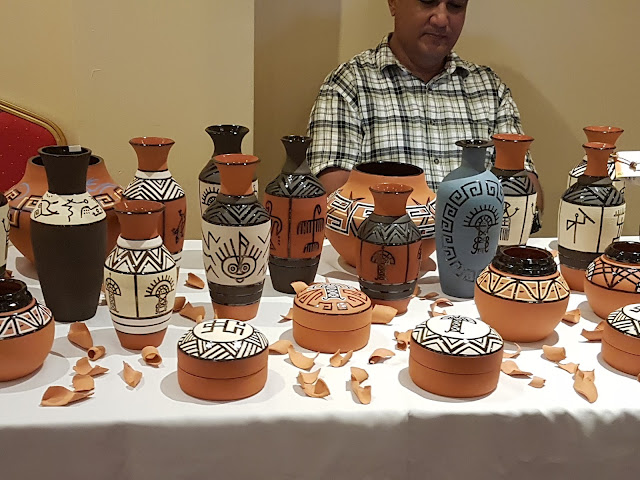
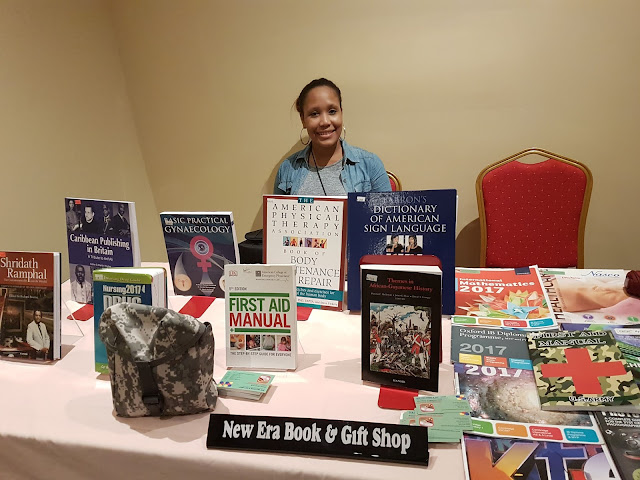
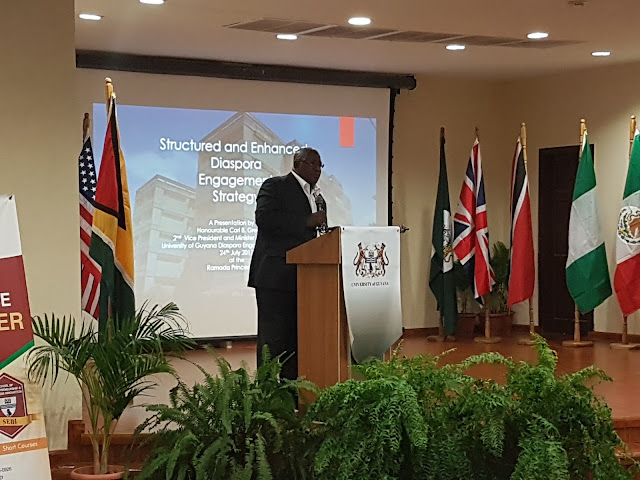
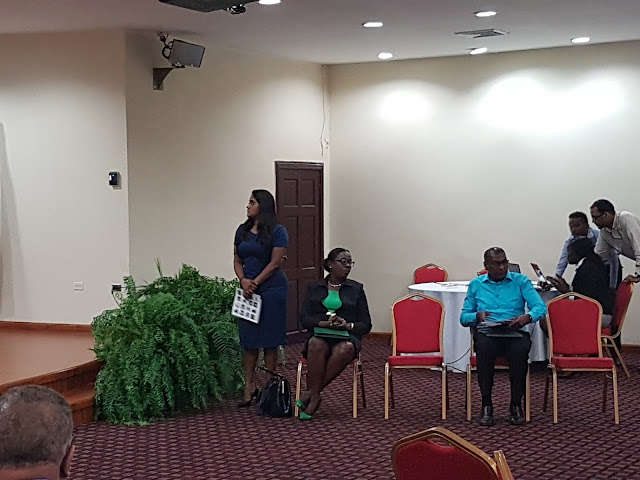
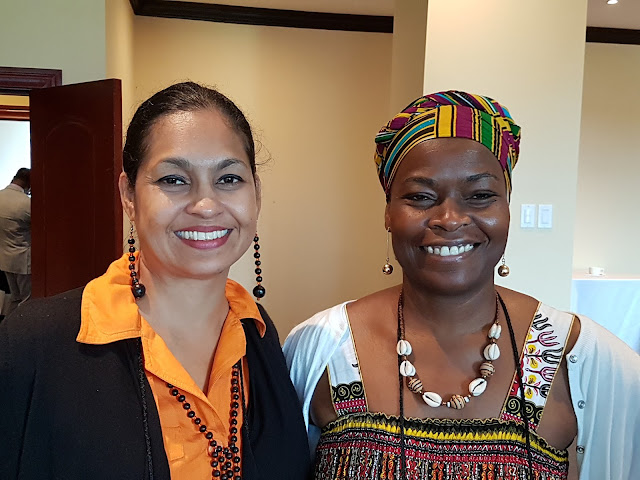
On the question of oil.
I don’t remember when exactly the oil discussion took place – though one of the papers was on this – but someone asked about the contract. They wanted to know where we could find it. I confess I’m not in favour of the oil industry development. There have been too many instances in my life time where this has proven to be a nightmare and destructive force to small countries forced to give unfavourable terms to multi-national corporations that have more wealth than those resource rich countries they exploit. What undeniably happens, as I recently read in the case of the small African nation of Equatorial Guinea (though what kind of ‘small’ we mean is another discussion) is that sickening, corrupt contracts are made with the so-called leaders whom the corporations give whatever revenues are yielded to directly whilst the mass of the population starves, the country continues in underdevelopment. Why should Guyana be different? In the Equatorial Guinea example, this disgusting deal was made with Exxon Mobil who directly paid money into the President’s bank account. Why does our government have faith that Exxon Mobil would grow moral fibres just for Guyana? Okay, so it wasn’t this administration with whom the contract was made. We were told at the conference that the contract was made with Janet Jagon in 1999, during her brief term as President. When administration changed in May 2015, British lawyers advised the government that owing to our border dispute with Venezuela it should be cautious about what goes out to the public. This is shocking – that Guyanese actually don’t know what’s in the contract. Further, former President Bharrat Jagdeo in 1997 added a non-disclosure clause in the petroleum Act. And something I didn’t catch properly about the ‘licensee being the one to give permission for disclosure.’ Someone who was there can authenticate the correct note. None of it should sit well with us. Put simply, we can’t see this contract. In the first place if this was made with the highest person in the land who has absolute power, then we can only move our mouths like we’re circulating saliva but can’t do anything to change the course of action weighing on this impending industry, positively or not. An industry that some at the conference, I couldn’t help noticing seemed entirely assured would bring great wealth to the nation. It seemed too that this industry would be so economically transforming for Guyana that we might as well get rid of bauxite, sugar and rice. There is a despairing sense that this winding down of same has already begun. I can’t see when disclosure would come since the border issue with Venezuela has been long. It’s being put before the international community at the end of this year, in any case.
We were further told about the 50/50% division of profits from oil revenues with the stomach churning caveat that this would be after the cost of investment had been accounted for. In other words, it would really be (if I understood the thing properly) 75/25% initially. How long this would last I didn’t hear. I hope at heart many of us were concerned about Guyana’s sovereignty and its development otherwise the blades of grass Venuezla claims will pale beside the probable ravages multinationals like Exxon Mobil are capable of imposing on ‘small’ countries.
Where were the Young People?
Any major gripe I have with the conference is that there wasn’t a contingent of young people present. I didn’t see any from the University doing a presentation or from the wider community. I communicated with a young man, who was a Civil Engineer teacher at UG who had brought a few of his students to the conference. I would have liked to see a panel discussion, chaired by and comprised of young people. This issue was raised on the last day and hopefully the feedback was noted along with others for organising future conferences. Importantly, there was a suggestion to develop a diaspora conference for young people. Perhaps the cost was prohibitive, if students were encouraged to attend, at $US50.
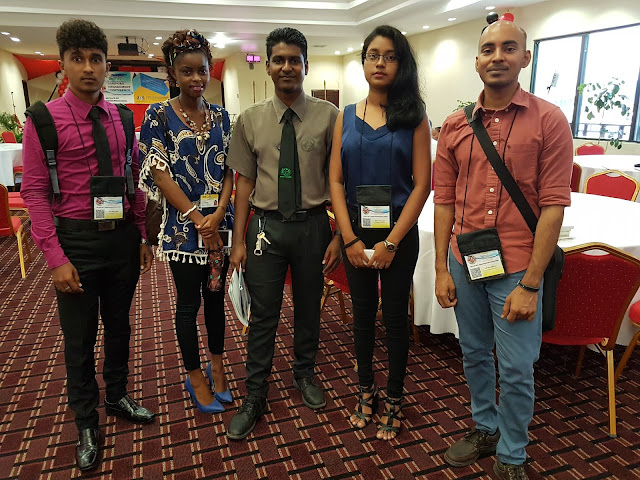
However, the Conference did offer an opportunity to engage with the community, including young people. This was the day to ‘give back,’ where delegates could take on a volunteering activity within the community. I went to a Youth Volunteering Day, held at Umana Yana. It was great to see young people engaged in development efforts aimed at supporting educational and social needs of other young people. There were groups pitching their ideas for development to a panel of judges. The winner was one that had developed an app called Maths Guru. I met some Youth Ambassadors. They were sponsored by the US Embassy to go to the United States for three weeks, take part in youth projects which they would return to Guyana and repackage in some form to offer to Guyanese youth. Most of the ambassadors were selected from Queens College. One, Visharnie, a previous QC student, bright and focused worked for the Guyana Chronicle and invited me to do an interview for the paper. This interview focused on culture, its lack, its potential in Guyana. She surprised me (pleasantly) and reinforced why I thought we needed the presence of our young people at the conference, by cutting to the chase and asking about the impact of cultural imperialism on the way we do or do not embed/institutionalise initiatives to promote, advance and centralise Guyanese cultural identity.
Cultural diversity?
At some point the fact that the majority of attendees were African Guyanese was made. It is a disgusting, shameful reality that events initiated to encourage wide participation when lead by an African Guyanese often results in a lack of involvement by Indian Guyanese. This has been my experience for years. I can’t speak to the ravages of the 1960s when the mud and blood were slinging both ways but in my lifetime I’ve observed efforts by African lead organisations to be inclusive of all the ethnicities. One of these is the Guyana UK Sports and Development Association, which organises a folk festival every year (for the last 20). This is for all Guyanese to take part in. But Indian Guyanese stay away. This has been the case no matter which administration is running the country or the ethnicity in the UK’s case of the High Commissioner. Of course, I can’t speak to events organised by Indian Guyanese or other groups where Africans are actively sought to attend? How would one know in a divisive society as ours? I know that I’d sooner see African Guyanese participating in the variety of festivals, donning clothes to reflect than I would the other way around. But that story is tired. A refresher to this came at an Emancipation event (I’ll blog separately on this) where Prime Minister Nagamootoo wore a dashiki, so too all his body guards.
An article by a Guyanese of Indian heritage suggesting that those Indian Guyanese who attended the conference were there for cronyish benefit was stupid for too many obvious reasons. The writer was there – looking, she suggests for her mattie and when seeing few, thought she was in the wrong place. Her comments remind me of a forefinger straining forward, an action which forces the thumb to invert backwards. The lack of representation by Indian Guyanese has nothing to do with the University since it’s an institution for all Guyanese, neighbours and international community. Invitations were far reaching for this reason.
If that writer’s comments can be described as stupid, John Mair’s comments (in an article he wrote about the conference) were insensitive and equally foolish. Firstly, he bemoaned being a ‘token white’ – if that’s how he chose to self-identify that’s his shame. In truth, did he expect organisers to rally minority numbers of ‘white’ (European/English/Spanish/Portuguese) Guyanese to satisfy some quota? As for renaming the ‘diaspora’ – ‘dire-spora’ – this suggests he really is ‘token’ that he is not one of us – however way we want to identify our connectedness with Guyana. When he referred to the President’s attendance with his ‘gang’ I was reminded of his paper (he presented same time as I) on the so-called ‘Guyanese Mafia’ a term he wants to have on record as his. Baroness Amos beamed one morning of the conference from a pre-recorded video and said Prince Charles had coined the term. I can’t stand it. Worse than this, however, and snakey too was his comment that the conference was a ‘coronation for the Vice Chancellor.’ The Vice Chancellor was hands on, but he didn’t ‘chair’ everything as Mair reported. This was a disgusting exaggeration. The Vice Chancellor tried to attend as many of the panels as possible, moving from room to room as we, the delegates were. Mair got personal about the VCs bowties too, though I couldn’t work out whether it was an endearment or slight. He might reflect (?) on his own curious eccentricity of writing as a pseudonym as well as in his own name in the same article; in other words referring to himself in the third person. He might chew on the hating notes in his paper, which probably have more to do with punctured privilege and realisation that when he’s in Guyana, he is a minority than anything else.
The cultural finale on the last night was disappointing. There was an attempt to be inclusive here too – something East Indian, Chinese, Indigenous and well – Dave Martins! We only live in some fickle hope that ‘inclusion’ might mean we don’t separate like this but revere and creatively demonstrate our coming together, attempting to ‘one people’ in a way I’ve observed Surimamese handle the diversity issue. Keith Waithe, the University’s Artiste in Residence had promised us something special, that we’d get the chance to dance and do weself. He would give us, one supposed a bit of something we might connect with African Guyanese. That didn’t happen. Unfortunately, the group of musicians he’d organised (comprising Rukiza Okera, Larry Bartley, Chris, Buxton Fusion and Helen McDonald) didn’t pull it off or even together and appeared to be rehearsing. I think it was unnecessarily elaborate, in any case. What would have worked in my humblish view is an array of drums. This would have sounded a timely note for emancipation, which was three days after the conference ended. The might of the drums would also have been appropriate to follow Dave Martins house tearing down act which had overrun and preceded Keith Waithe et al. And yet here too there were some comments about a lack of diversity on this night. And on and on the racist bile prevails.
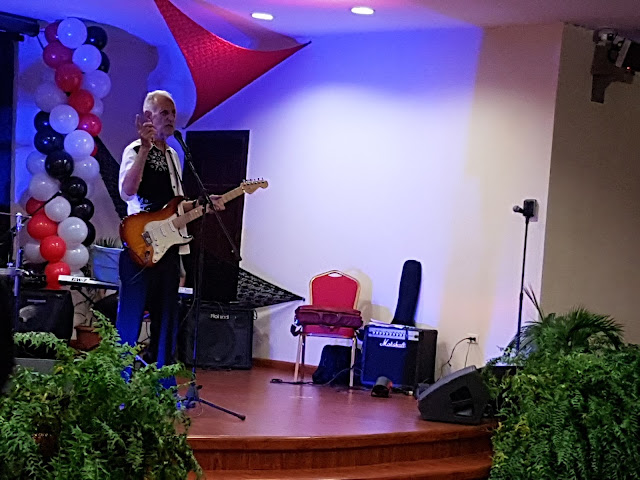
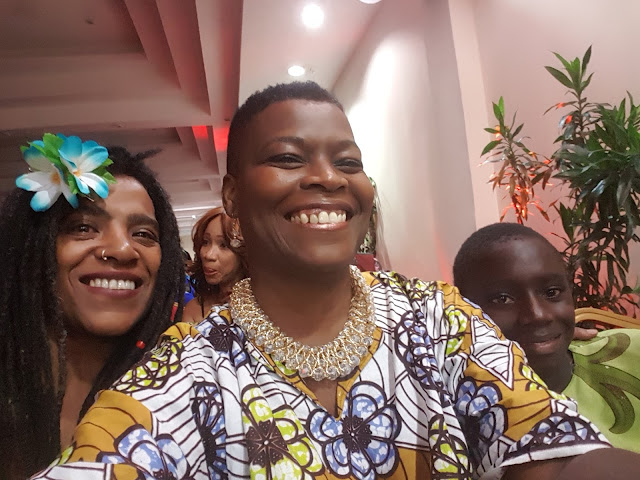
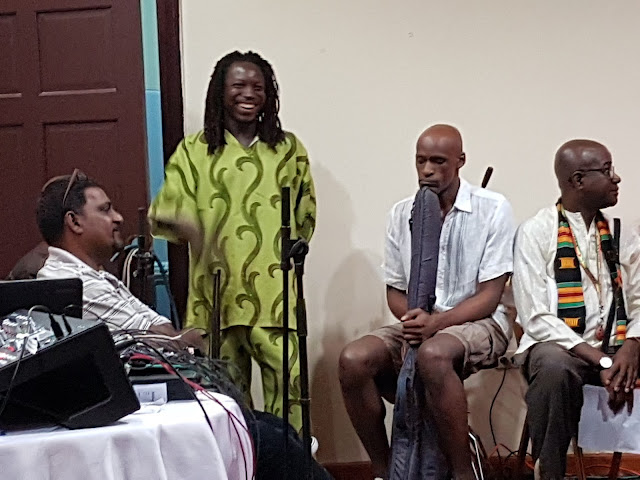
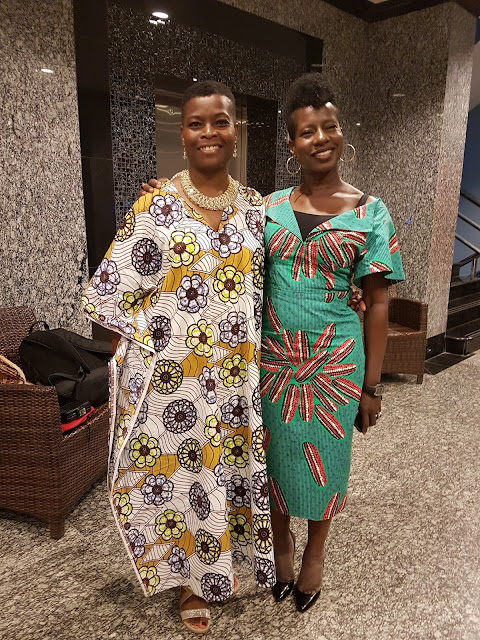
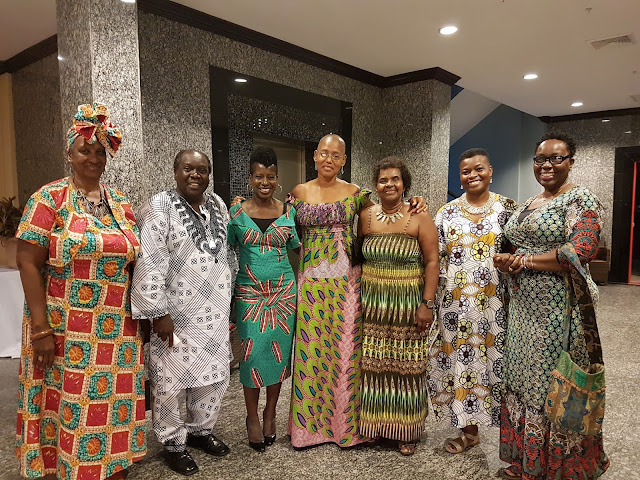
The Investiture – of the Vice Chancellor Ivelaw Griffith
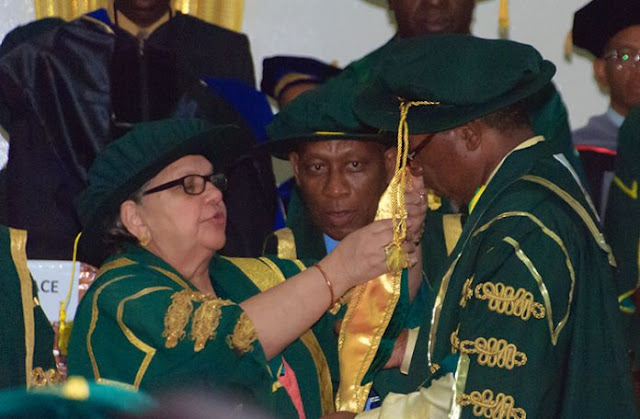 (photo from Guyana Chronicle; see their article on the ‘installing’ here)
(photo from Guyana Chronicle; see their article on the ‘installing’ here)
I thought I could have ducked this programming of the conference. I didn’t know how ‘formal’ the thing was, didn’t know what an ‘investiture’ was. I went and it really was pomp, as I now realise these things are. Felt woefully underdressed in my newly purchased UG and DEC tee – merchandise I was glad to support. The President, Prime Minister, other Ministers, UG Chancellor, UG faculty members and Deputy Vice Chancellors (I was surprised that there were more than one); guests from different parts of the world and their respective universities all there to see the installation of the 10th Vice Chancellor to the University of Guyana. I can (outside and inside the event itself) see and hear the cries about it because it is change. What I can’t witness more directly are the sneers by those who think the diaspora (Professor Griffith representing) are taking over. I’d have to be resident proper to appreciate that aspect and the quarters whence it cometh. For whatever reason and however it was made possible, who can really envy the Vice Chancellor the role he accepted? Anyone who merely dreams, I suppose.
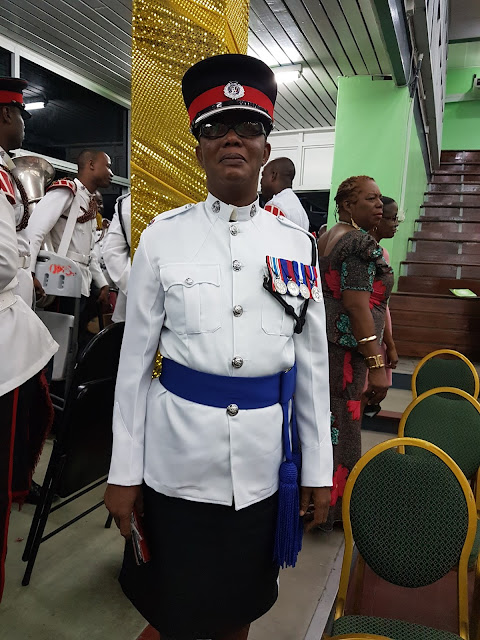
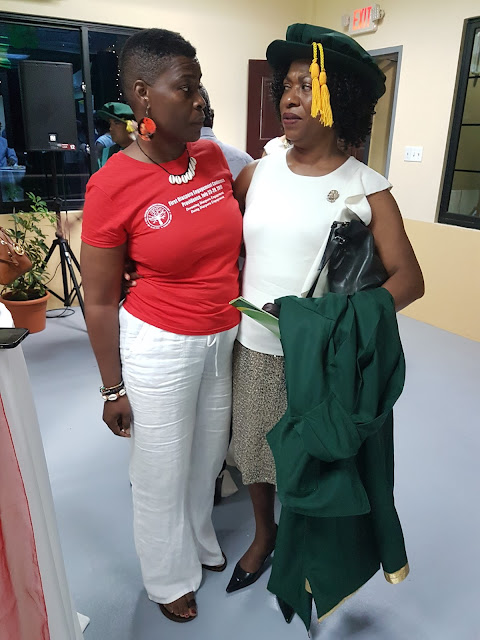
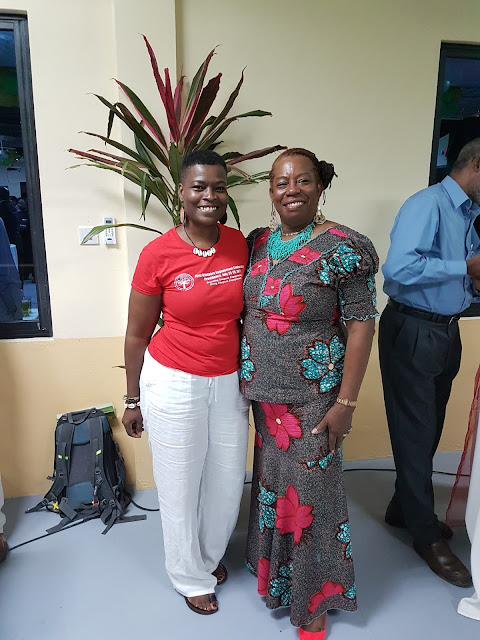
Building bridges
Finally, I had to acknowledge it was worth being present at the conference because it gave the occasion to get to know other Guyanese living outside. Whatever the reasons they attended the conference I got a sense that there was a serious commitment to helping Guyana to develop. We have between us earned extensive skills in all fields that can contribute to this process. And many have been trying for years to find ways to ‘give back.’ We could all lament the seemingly deliberate closed doors and bureaucratic instruments that have stopped our collective/individual efforts – be they to return and teach, set up sports clubs, contribute hospital supplies, rebuilding schools, supplying schools with computers/books, facilitating literacy initiatives, wide ranging business enterprises (using local produce/services), helping to alleviate mental health and other medical issues, domestic violence, particularly against women and so on. It was noted that many of us (I am one) who left Guyana didn’t do so by choice. The sense that when we come back we’re seen as ‘stepping on toes’ is something we learn to live with. At least I have. The conference organisers didn’t consciously enable those present to make connections with each other, by say making it part of a programme/morning or afternoon; that had to be organic. It would have been good to have a sense of who was in the room, but with our last minuteness (mine included) that might be a stretched expectation. The chance to get to know Guyana was programmed, I’ll write on this in another post. But this would have served as an opportunity to connect.
We can measure the success of the conference in so many ways. I choose simply to refer to its inception. It had to be dreamed up, in the first place. Then believed possible. Who would dream only and not attempt the practical steps to realise their vision? So although the theme appeared philosophically fluffy to my ear and mouthing and laughter at times I fully appreciate what has been achieved by this initiative, which began with a dream or vision. One of the outcomes was the launch of the Centre for Caribbean Diaspora Engagement. Another was the signing of a Memorandum of Understanding between the University of Guyana and University of the West Indies. The Investiture, too, set a new standard, like it or not. The conference brought together people who would otherwise never be seen together because of our respective interests. And we don’t have to like each other, nor share the same ideology. We need as a start to recognise that the University has attempted in this initiative to be a mobilising force, and its new Vice Chancellor seems serious about the business of running it with the necessary contribution of key players, just as elsewhere Universities are developed, maintained and become important instruments through which the moral, philosophical, political, social, economic and cultural values of a nation are progressed. Many of the delegates are the University of Guyana Alumni, perhaps attesting to their interest and genuine desires to give back. Success then is what we make of it – and my gratitude to the Vice Chancellor and team for organising this first Diaspora Conference is fully expressed here.

